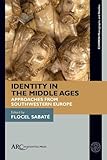Identity in the Middle Ages : Approaches from Southwestern Europe / ed. by Flocel Sabaté.
Material type: TextSeries: CARMEN monographs and studiesPublisher: Leeds : ARC Humanities Press, [2021]Copyright date: ©2021Description: 1 online resource (522 p.)Content type:
TextSeries: CARMEN monographs and studiesPublisher: Leeds : ARC Humanities Press, [2021]Copyright date: ©2021Description: 1 online resource (522 p.)Content type: - 9781641892599
- 305.80094 23
- D900 .I34 2021
- online - DeGruyter
| Item type | Current library | Call number | URL | Status | Notes | Barcode | |
|---|---|---|---|---|---|---|---|
 eBook
eBook
|
Biblioteca "Angelicum" Pont. Univ. S.Tommaso d'Aquino Nuvola online | online - DeGruyter (Browse shelf(Opens below)) | Online access | Not for loan (Accesso limitato) | Accesso per gli utenti autorizzati / Access for authorized users | (dgr)9781641892599 |
Frontmatter -- CONTENTS -- List of Illustrations -- Foreword -- Introduction. Identity in the Middle Ages -- Chapter 1. Identity as a Historiographical Concept -- PART ONE: CONSTRUCTING INDIVIDUAL IDENTITY -- Chapter 2. Baptismal Names and Identity in the Early Middle Ages -- Chapter 3. Personal Names and Identity in the Iberian Peninsula -- Chapter 4. Gender and Feminine Identity in the Middle Ages -- Chapter 5. Identity, Memory, and Autobiographical Writing in Twelfth- and Thirteenth-Century French Literature -- Chapter 6. Why Ibn Ḥazm became a Ẓāhirī: Law, Charisma, and the Court -- Chapter 7. Eunuchs in the Emirate of al-Andalus -- PART TWO: SOCIAL IDENTITIES -- Chapter 8. Identity and Minority Status in Two Legal Traditions -- Chapter 9. Medieval Peasants’ Image of Themselves in Relation to the Seigneurial Regime -- Chapter 10. Chivalric Identity: Arms and Armour, Text and Context -- Chapter 11. The Emergence of a Bourgeois Urban Identity: Late Medieval Catalonia -- Chapter 12. Culture and Marks of Identity among the Social Outcasts and Criminals of Late Medieval Spain -- PART THREE: IDENTITY AND TERRITORY -- Chapter 13. Identity and the Rural Parish in Medieval Iberia -- Chapter 14. The Breakdown of Vertical Solidarity among the Late Medieval Basque Nobility -- Chapter 15. Identity-Making Discourses in the Kingdom of Sardinia and Corsica and the Giudicato of Arborea -- Chapter 16. The Crown of Aragon and the Regnum Sardiniae et Corsicae in the Fourteenth Century: Comparing Institutional Identities -- PART FOUR: REPRESENTATIVE COLLECTIVE IDENTITIES -- Chapter 17. Political Identity and Patrician Power in the City of Burgos during the Fifteenth Century -- Chapter 18. Fiscal Attitudes and Practices and the Construction of Identity in Late Medieval Cuenca -- Chapter 19. Constructing an Identity: Urban Centres and their Relationship with the Crown of Navarre, 1300–1500 -- Chapter 20. Celebration of Identity in Thirteenth- to Fifteenth-Century Florence, Milan, and Venice -- Chapter 21. Local and “State” Identities in Cities of Fifteenth- and Sixteenth-Century Northern and Central Italy
restricted access online access with authorization star
http://purl.org/coar/access_right/c_16ec
This book places identity at the centre of a project to better understand medieval society. By exploring the multiplicity of personal identities, the ways in which these were expressed within particular social structures (such as feudalism), and their evolution into formal expressions of collective identity (municipalities, guilds, nations, and so on) we can shed new light on the Middle Ages. A specific legacy of such developments was that by the end of the Middle Ages, a sense of national identity, supported by the late medieval socio-economic structure, backed in law and by theological, philosophical, and political thought, defined society. What is more, social structures coalesced across diverse elements, including language, group solidarities, and a set of assumed values.
Mode of access: Internet via World Wide Web.
In English.
Description based on online resource; title from PDF title page (publisher's Web site, viewed 01. Dez 2022)


